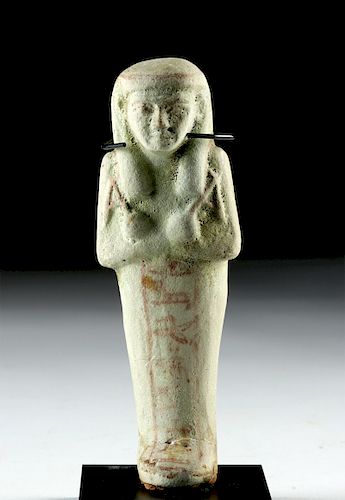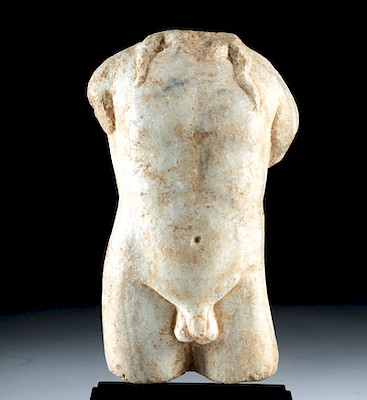Large Egyptian Faience Ushabti for Pa-shery-en-Iset
Lot 3a
About Seller
Artemis Fine Arts
686 S Taylor Ave, Ste 106
Louisville, CO 80027
United States
Selling antiquities, ancient and ethnographic art online since 1993, Artemis Gallery specializes in Classical Antiquities (Egyptian, Greek, Roman, Near Eastern), Asian, Pre-Columbian, African / Tribal / Oceanographic art. Our extensive inventory includes pottery, stone, metal, wood, glass and textil...Read more
Estimate:
$1,400 - $2,000
Absentee vs Live bid
Two ways to bid:
- Leave a max absentee bid and the platform will bid on your behalf up to your maximum bid during the live auction.
- Bid live during the auction and your bids will be submitted real-time to the auctioneer.
Bid Increments
| Price | Bid Increment |
|---|---|
| $0 | $25 |
| $300 | $50 |
| $1,000 | $100 |
| $2,000 | $250 |
| $5,000 | $500 |
| $10,000 | $1,000 |
| $20,000 | $2,500 |
| $50,000 | $5,000 |
| $100,000 | $10,000 |
| $200,000 | $20,000 |
About Auction
By Artemis Fine Arts
Dec 5, 2018
Set Reminder
2018-12-05 10:00:00
2018-12-05 10:00:00
America/New_York
Bidsquare
Bidsquare : DAY 1 | Classical Antiquities & Asian Art
https://www.bidsquare.com/auctions/artemis-gallery/day-1-classical-antiquities-asian-art-3698
Day 1 of an important 2-day auction featuring ancient and ethnographic art from around the world. Egyptian, Greek, Roman, Viking, Near Eastern plus Asian Art from China, Japan, Thailand, Vietnam, Burma, India, more. Artemis Fine Arts info@artemisfinearts.com
Day 1 of an important 2-day auction featuring ancient and ethnographic art from around the world. Egyptian, Greek, Roman, Viking, Near Eastern plus Asian Art from China, Japan, Thailand, Vietnam, Burma, India, more. Artemis Fine Arts info@artemisfinearts.com
- Lot Description
Ancient Egypt, Third Intermediate Period, 21st to 25th Dynasty, ca. 1070 to 664 BCE. A lovely, mold-formed faience ushabti standing in mummiform atop an integral ovoid plinth and covered in a pale green glaze. The figure holds a pair of hoes delineated with mauve-hued pigment in crossed arms, and a similarly-colored seed bag is draped across the verso. A wide nose, full lips, almond-shaped eyes, and thin brows comprise the serene visage, and the top of the tripartite wig is adorned with a ring of mauve pigment. An inscribed column of painted hieroglyphic text denotes this figure as Pa-shery-en-Iset (literally "The child of Isis"), the second prophet of Amun. Custom museum-quality display stand included. Size: 1.875" W x 5.625" H (4.8 cm x 14.3 cm); 6" H (15.2 cm) on included custom stand.
The following is excerpted from a letter by Dr. Campbell Price, Curator of Egypt and the Sudan, Manchester Museum, The University of Manchester in the UK, regarding this ushabti. It reads, "After consultation with a colleague based near here in Manchester, I am able to tell you that the shabti depicts the 2nd Prophet of Amen, Pa-shery-en-Iset (lit: 'The child of Isis'), who was buried in Middle Egypt, at the site of Hermopolis, tomb no.2, found in 1926 (for further details, see the journal Annales du Service des Antiquities de l'Egypte no. 26, 1926, pp. 41-43). As so often, the finds from the tomb were split up and some entered the private art market - including this chap."
Provenance: private Vero Beach, Florida, USA collection; ex-private American family collection since 1945
All items legal to buy/sell under U.S. Statute covering cultural patrimony Code 2600, CHAPTER 14, and are guaranteed to be as described or your money back.
A Certificate of Authenticity will accompany all winning bids.
We ship worldwide and handle all shipping in-house for your convenience.
#141800Repairs to feet with small chips and light adhesive residue along break lines. Fading to original glaze color and applied pigment, minor pitting and abrasions, and a couple of stable hairline fissures around midsection. Light earthen deposits throughout.Condition
- Shipping Info
-
All shipping is handled in-house for your convenience. Your invoice from Artemis Gallery will include shipping calculation instructions. If in doubt, please inquire BEFORE bidding for estimated shipping costs for individual items.
-
- Buyer's Premium



 EUR
EUR CAD
CAD AUD
AUD GBP
GBP MXN
MXN HKD
HKD CNY
CNY MYR
MYR SEK
SEK SGD
SGD CHF
CHF THB
THB














